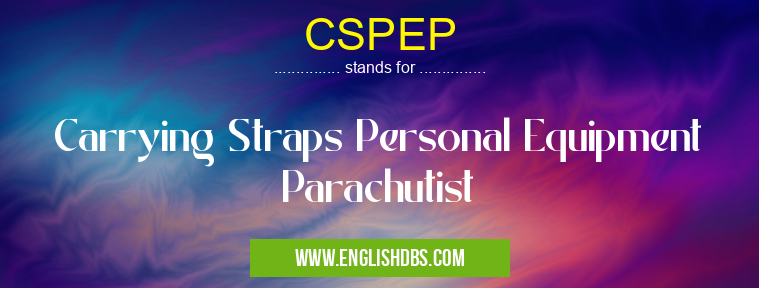What does CSPEP mean in UNCLASSIFIED
CSPEP stands for Carrying Straps Personal Equipment Parachutist. It is a specialized equipment used by paratroopers to carry their personal equipment and supplies during airborne operations. The CSPEP is designed to provide a comfortable and secure way to transport essential gear while maintaining maneuverability and reducing fatigue.

CSPEP meaning in Unclassified in Miscellaneous
CSPEP mostly used in an acronym Unclassified in Category Miscellaneous that means Carrying Straps Personal Equipment Parachutist
Shorthand: CSPEP,
Full Form: Carrying Straps Personal Equipment Parachutist
For more information of "Carrying Straps Personal Equipment Parachutist", see the section below.
Components and Features
The CSPEP typically consists of:
- Adjustable shoulder straps: Designed to fit snugly over the paratrooper's shoulders, ensuring a secure fit during jumps and landings.
- Chest strap: Helps to distribute weight evenly across the torso, reducing strain on the shoulders and back.
- Waist belt: Provides additional support and stability to the lower body, preventing the gear from shifting during impact.
- Attachment points: Allow for the attachment of various pouches, bags, and accessories, accommodating a wide range of equipment needs.
- Quick-release buckles: Enable the paratrooper to quickly detach the CSPEP in case of an emergency, ensuring safety during landing and extraction procedures.
Benefits of Using CSPEP
- Enhanced mobility: The CSPEP distributes weight effectively, allowing paratroopers to move freely and perform various maneuvers without hindrance.
- Reduced fatigue: By evenly distributing weight, the CSPEP helps reduce muscle strain and fatigue, enabling paratroopers to maintain their physical capabilities throughout operations.
- Secure and reliable: The adjustable straps and quick-release buckles ensure a secure fit and prevent gear from becoming loose or dislodged during jumps and landings.
- Customization: The CSPEP can be customized to meet the specific equipment needs of individual paratroopers, allowing them to carry essential supplies while minimizing bulk and weight.
Essential Questions and Answers on Carrying Straps Personal Equipment Parachutist in "MISCELLANEOUS»UNFILED"
What is CSPEP?
CSPEP stands for Carrying Straps Personal Equipment Parachutist and refers to the harness system used by paratroopers to carry their personal equipment and parachute during airborne operations.
What are the components of a CSPEP system?
A CSPEP system typically consists of a harness, shoulder straps, leg straps, a quick-release buckle, and a parachute attachment point.
How is a CSPEP system worn?
The harness is worn around the waist and legs, with the shoulder straps crossing over the shoulders. The parachute is attached to the harness using the attachment point, and the quick-release buckle is secured in front.
What are the safety features of a CSPEP system?
CSPEP systems are designed with multiple safety features, including a quick-release buckle that can be operated with one hand, leg straps to prevent the harness from riding up, and a padded harness for comfort and support.
Who uses CSPEP systems?
CSPEP systems are primarily used by military paratroopers and civilian skydivers.
How is a CSPEP system maintained?
CSPEP systems should be inspected regularly for any signs of wear or damage. They should also be cleaned and lubricated as per the manufacturer's instructions.
What are the advantages of using a CSPEP system?
CSPEP systems provide paratroopers with a safe and comfortable way to carry their equipment and parachute during airborne operations. They allow for quick and efficient deployment of the parachute, and they help to distribute the weight of the equipment evenly.
Final Words: The CSPEP is an essential piece of equipment for paratroopers, providing a comfortable, secure, and efficient way to carry personal equipment during airborne operations. Its adjustable features, secure attachment points, and quick-release buckles enhance mobility, reduce fatigue, and ensure safety during jumps and landings. By using the CSPEP, paratroopers can effectively fulfill their missions while maintaining their physical capabilities and operational readiness.
